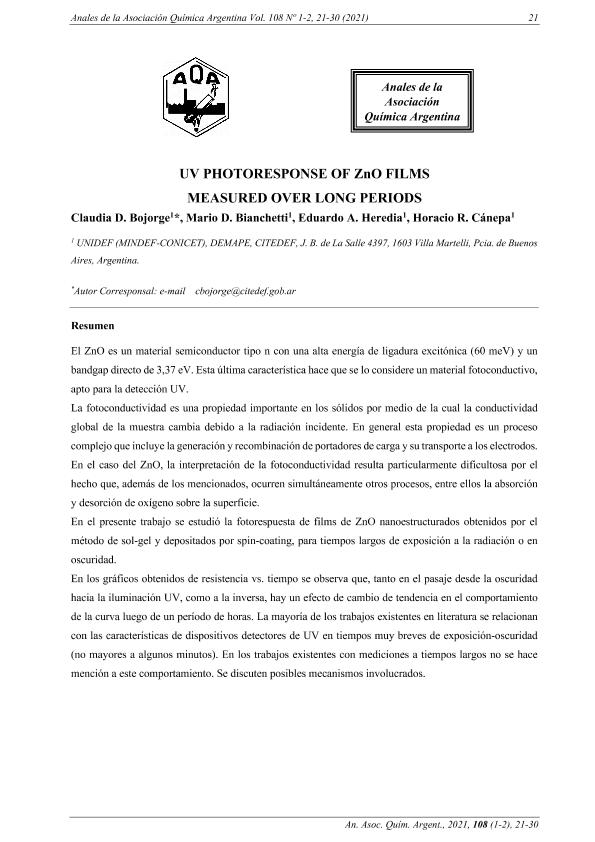Artículo
El ZnO es un material semiconductor tipo n con una alta energía de ligadura excitónica (60 meV) y un bandgap directo de 3,37 eV. Esta última característica hace que se lo considere un material fotoconductivo, apto para la detección UV. La fotoconductividad es una propiedad importante en los sólidos por medio de la cual la conductividad global de la muestra cambia debido a la radiación incidente. En general esta propiedad es un proceso complejo que incluye la generación y recombinación de portadores de carga y su transporte a los electrodos. En el caso del ZnO, la interpretación de la fotoconductividad resulta particularmente dificultosa por el hecho que, además de los mencionados, ocurren simultáneamente otros procesos, entre ellos la absorción y desorción de oxígeno sobre la superficie. En el presente trabajo se estudió la fotorespuesta de films de ZnO nanoestructurados obtenidos por el método de sol-gel y depositados por spin-coating, para tiempos largos de exposición a la radiación o en oscuridad. En los gráficos obtenidos de resistencia vs. tiempo se observa que, tanto en el pasaje desde la oscuridad hacia la iluminación UV, como a la inversa, hay un efecto de cambio de tendencia en el comportamiento de la curva luego de un período de horas. La mayoría de los trabajos existentes en literatura se relacionan con las características de dispositivos detectores de UV en tiempos muy breves de exposición-oscuridad (no mayores a algunos minutos). En los trabajos existentes con mediciones a tiempos largos no se hace mención a este comportamiento. Se discuten posibles mecanismos involucrados. ZnO is an n-type semiconductor material with a high exciton binding energy (60 meV) and a direct bandgap of 3.37 eV. This last characteristic makes it considered a photoconductive material, suitable for UV detection. Photoconductivity is an important property in solids whereby the overall conductivity of the sample changes due to incident radiation. In general, this property is a complex process that includes the generation and recombination of charge carriers and their transport to the electrodes. In the case of ZnO, the interpretation of photoconductivity is particularly difficult due to the fact that, in addition to the aforementioned effects, other processes occur simultaneously, including the absorption and desorption of oxygen on the surface. In the present work, the photo response of nanostructured ZnO films obtained by the sol-gel method and deposited by spin-coating, was studied for long times of exposure to radiation or in the dark. On the resistance vs. time curves, it is observed that, both in the passage from darkness to UV illumination and vice versa, there are changes in the behavior of the curve after a period of hours. Most of the existing works in the literature are related to the characteristics of UV detection devices in very short exposure-dark times (no longer than a few minutes). In the existing works with measurements at long times, there is no mention about this behavior. Possible mechanisms involved are discussed.
Uv photoresponse of ZnO films measured over long periods
Bojorge, Claudia Daniela; Bianchetti, Mario Fidel ; Heredia, Eduardo Armando; Canepa, Horacio Ricardo
; Heredia, Eduardo Armando; Canepa, Horacio Ricardo
 ; Heredia, Eduardo Armando; Canepa, Horacio Ricardo
; Heredia, Eduardo Armando; Canepa, Horacio Ricardo
Fecha de publicación:
12/2021
Editorial:
Asociación Química Argentina
Revista:
Anales de la Asociación Química Argentina
ISSN:
0365-0375
e-ISSN:
2545-8655
Idioma:
Inglés
Tipo de recurso:
Artículo publicado
Clasificación temática:
Resumen
Palabras clave:
ZnO
,
nanocrystalline films
,
photoconductivity
,
UV
Archivos asociados
Licencia
Identificadores
Colecciones
Articulos(UNIDEF)
Articulos de UNIDAD DE INVESTIGACION Y DESARROLLO ESTRATEGICOS PARA LA DEFENSA
Articulos de UNIDAD DE INVESTIGACION Y DESARROLLO ESTRATEGICOS PARA LA DEFENSA
Citación
Bojorge, Claudia Daniela; Bianchetti, Mario Fidel; Heredia, Eduardo Armando; Canepa, Horacio Ricardo; Uv photoresponse of ZnO films measured over long periods; Asociación Química Argentina; Anales de la Asociación Química Argentina; 108; 1-2; 12-2021; 21-30
Compartir



